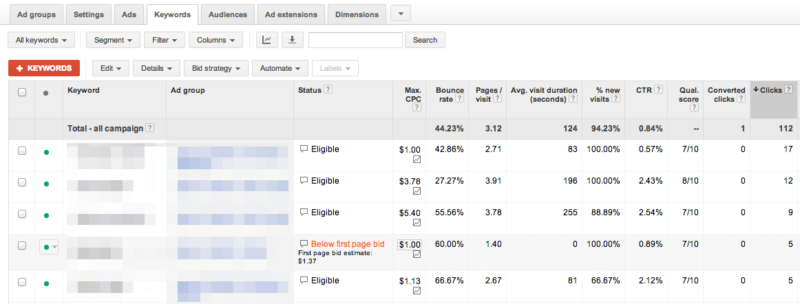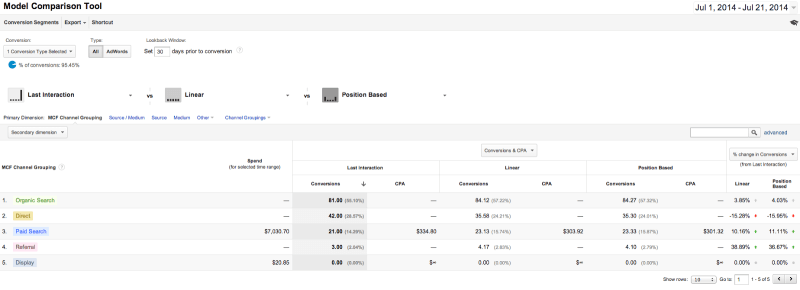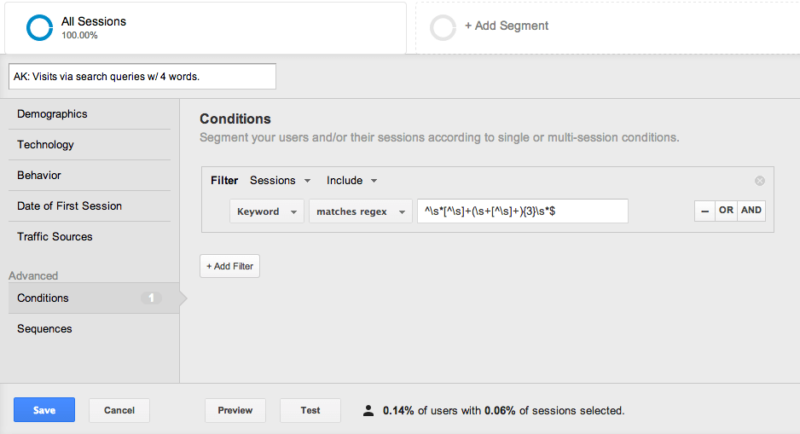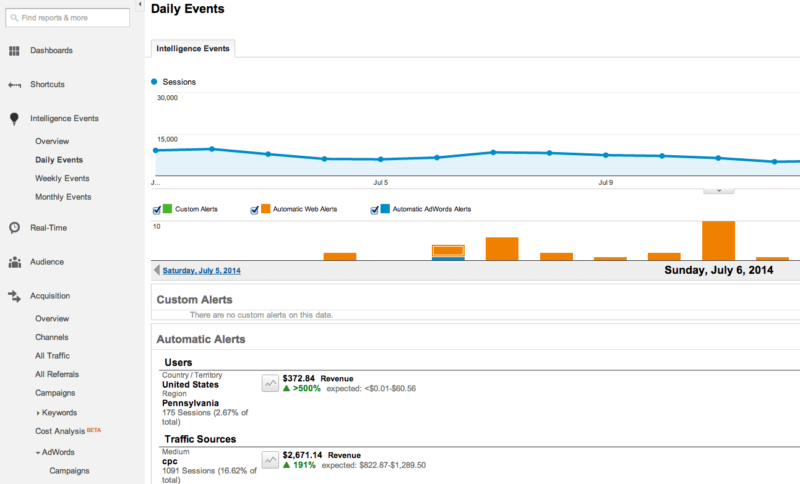How to Read Adwords in Google Analytics

I recently hosted a Hangout for the Google Partners customs well-nigh how Google Analytics (GA) and AdWords can piece of work together to help better PPC results.
With the speed at which new features go added, it's like shooting fish in a barrel to overlook one or 2 cool capabilities so hither'south a roundup of 10 of my favorite ways to use Analytics to improve AdWords performance. Some of these reports are oldies but goodies and some are but a few weeks one-time, simply they all deserve to be part of our SEM toolkits.
AdWords And Analytics: Amend Together
AdWords is peachy at telling yous how much money your ads cost and how many conversions you lot're getting but what happens between the click and the conversion remains a mystery unless yous add together GA to the equation. It can tell yous what people practise on your site, so if they're not converting, it tin aid you detect out why. And when you can fix conversion rate issues, your AdWords functioning will get better.
The simplest way to become started is to import a GA view into AdWords to get access to four new data columns: "Bounce Rate," "Pages/visit," "Avg. visit duration," and "% new visits." These can exist extremely helpful to get a more complete view of what is happening with your ads. Let me give an example next…
Don't Delete Zero Conversion Keywords
…at least not before asking a few more than questions first. Say y'all have a bunch of keywords that take 0 conversions. You might exist thinking virtually deleting these or lowering the bids drastically. But proceed in mind that the conversions you see in AdWords are terminal-click conversions, and then only the last keyword that got a click in AdWords volition get the credit for the conversion.
Knowing that many consumers do multiple searches while researching a purchase, it's obvious why making a decision based solely on last-click conversions might be the wrong one… y'all might exist eliminating the keywords that drive upper funnel activity, leaving yourself with fewer users who come out at the terminate of the funnel too.
Here are two things yous tin do to check if these are truly bad keywords:
1. Check if you have high engagement for these keywords, e.g., loftier numbers for "avg. visit duration" and "pages/visit," every bit this tin be an indicator that the trouble isn't with the keywords but rather with your site where the users are not finding what it is you lot promised them in the ad.
After all, a user who spends a lot of time on the site must retrieve they've come to the correct place, they're just not finding what they need hands. The solution in this instance could be to attempt more than relevant landing pages.

Add the Analytics columns "avg. visit elapsing" and "pages/visit" to AdWords to assist you find keywords that bring in engaged users.
2. Look at the column "% new visits" to see if these keywords are driving new users into your funnel. If the keyword drives a lot of new visitors, the next step is to use the Search Funnels report in AdWords or the Assisted Conversions written report in GA to see if these new users eventually convert using different keywords, or even through unlike channels.
If this is the case, try to figure out how to value these keywords because eliminating them could really backfire.

Use Search Funnels information to determine if 0-conversion keywords may be driving upper funnel activity and get-go-click or assisted conversions.
To help decide on a model for how to value these keywords, try the GA Model Comparing Tool, which will testify yous the value of each keyword using some standard models, or using your own custom 1.

Apply the Attribution Model Comparison Tool to try out unlike attribution models similar Last Interaction, Offset Interaction, or Position Based, to get a better grasp on the truthful value of your PPC.
Find Bad Landing Pages Quickly
Use the columns "bounce rate" and "avg. fourth dimension on site" in addition to "conversion charge per unit" to find ads that are neither converting, nor engaging users.
Then analyze the worst offenders and bucket them based on the likely solutions which could be one of the following: ready the keyword relevance, pick a better landing folio, fix ads that may be misleading, or if your site has a high bounce rate across the board, address the elements that seem to make users think your site is not trustworthy.
While AdWords provides a good starting point to find poor landing pages, 1 of the issues is that it's not good at accumulation the information. What I hateful is that you have to ask the same question over and over over again in many different ad groups.
To be efficient yous should look at the data for landing pages across your whole account, and this is where the GA Landing Page report comes in handy. If several ad groups employ the same landing folio URLs, it totals up all the stats for you so that it'south easier to speedily hone in on bad landing pages that may be used in many places throughout the account.
GA Lets You Track More Circuitous Conversions
The AdWords conversion tracking code I helped create over 10 years ago (my first project with the AdWords product team) nevertheless serves its purpose well for tracking unproblematic conversions.
However, many advertisers want to track more simply views of a key folio similar the club confirmation page, east.g., how many people chosen after visiting your site from an advertizing, or how many people watched your production demo video. Both of these actions don't take a respective folio and then tracking is a fleck more complex.
In the instance of tracking phone calls after the ad is clicked, the third-party vendor that handles your call tracking (Mongoose Metrics, IfByPhone, CallRail, LogMyCalls, …) will fire either an effect or a virtual folio view to GA when a call lasts longer than your specified minimum elapsing.
That in plow is ready as a goal which tin then be imported back into AdWords, and associated back to the GCLID (Google's click tracking parameter that helps it uniquely identify every click) so that it shows up as a conversion adjacent to the correct keyword, ad, and advertizement group.
The merely real downside, in my stance, of using GA to track conversions is that there is a bit of a filibuster for when they are imported: ordinarily 24 to 48 hours but sometimes 72 hours!
As a upshot of this delay, your AdWords CPAs volition always expect pretty weak for the past 2 days so if you're trying to manage bids very oftentimes using but data from AdWords, you have the added complication of having to account for the delayed conversion data.
When You lot Have No Macro Conversions, Look At Micro-Conversions
A common problem in AdWords is that it's difficult to rails different types of conversions when you don't necessarily desire to treat all types of conversions the same.
A elementary instance is that yous take two campaigns, one with the goal of selling products, the other with the goal of building your electronic mail list. If you track both conversions, both campaigns will reflect both conversion types and it's hard to segment it back out and so that y'all're not counting email signups as sales in the campaign that is trying to sell products.
In that location are a few possible solutions in AdWords, e.thousand., you can choose to count unique conversions or just converted clicks if you don't want to double count leads, or you can assign a conversion value of 0 to conversions you don't desire to cistron into an ROAS based bid strategy, simply sometimes you want something a lilliputian more sophisticated.
In AdWords, it's only not easy to come across data broken out by individual conversions. In Analytics, on the other hand, y'all tin easily customize an AdWords campaign report to bear witness several types of goals side past side, making it much easier to understand what the users are doing later they click your ad.

Compare the functioning of all of your goals side-by-side using the AdWords Campaigns report in Analytics. Y'all tin even meet the performance of goals you don't import as conversions.
You lot tin fifty-fifty use this data in cases where yous're not successfully driving the expected conversion. By looking at dissimilar conversion types, you'll see if those keywords are at least driving some signups for the newsletter, or completing another micro conversion on your site, something that still has some value or that could exist a predictor of a sale much further downwardly the line.
Once you determine that a detail campaign is a bit weak in terms of driving the completion of conversions, you can use the Goal Flow report to compare how different campaigns motion users through the stages of your funnel.
This can help identify where the users are dropping off. Perhaps there's one of the pages in the funnel that's just not working well for some users, for example, if you charge for aircraft and you don't take a cheaper option for the products in your new line of value-oriented products, that could cause a significant drop-off compared to your other product lines.

Compare the Goal Flow written report for all your AdWords campaigns on a single screen to help notice if a particular entrada is doing a poor job of moving users through your funnel.
Being #one Isn't Always Great
If you manage AdWords ads and you're not the boss at the visitor, you've probably gotten a frantic call from someone higher up the chain to enquire: "Why aren't our ads in position 1 anymore?!?"
A practiced answer would be to explain that ad positions were tested and it was determined that the top slot was non worth the extra cost. Or possibly you tin fifty-fifty prove that the conversion rates are actually worse at the top of the page than on the right side.
Google's Chief Economist Hal Varian addressed this topic back in 2009, and while he found little variation in conversion rate by position, it would however exist overnice to confirm that this 5-year-old information is all the same true, and more than chiefly, that information technology applies to your business which is non average. The easiest fashion to go the information to make your instance is in the Analytics Keyword Positions report.

Understand Your Segments
As Susan Waldes points out in her recent post on managing an account with 10 keywords, when you take 1 keyword that yous're managing, you're really managing that keyword across potentially hundreds of segments. Agreement how each segment performs is crucial to making the right optimizations in your account.
The segmentations we all expect at include dayparts, geographic regions and devices. While AdWords does an okay job making these segments attainable, GA does a better task, and with their advanced segment builder, you tin do some really cool things.
For instance, Google's Digital Evangelist Avinash Kaushik explained how you could segment operation past the length of your keywords (curl all the style to section 3 of his postal service) so that you lot could figure out if information technology's actually worth adding thousands of 6-discussion keywords to your account.
Last calendar week, Google automatic a segment we previously had to create manually that segments make and non-brand keywords. Yous can at present fifty-fifty build segments to analyze user cohorts, for example, to see what happens with users who first visited in July and saw a particular ad I was running then.

Create custom segments to have a deeper wait at the information, and uncover if at that place are segments that aren't performing as well as others.
Some other corking benefit of Google Analytics is that you lot tin have whatsoever segment and turn it into a remarketing audience list in a unmarried click.
Fifty-fifty though nosotros all empathize the power of looking at our data in a segmented manner, the truth is that there are also many segments to analyze manually.
Analytics has an reply for that, too, and you can utilize the Intelligence Alerts to let Google do all the hard piece of work for you. Y'all can look at the report and see but data for AdWords, looking for either things that are unusual over a brusk period with daily alerts, or looking at longer trends using weekly or monthly reports.

Intelligence Events for AdWords automatically identify anomalies in the functioning of your ads.
And That's Why AdWords Is Meliorate With Analytics
So those are 10 things I look at in Google Analytics to make meliorate decisions in AdWords. Here'due south the total list:
-
Apply the "pages/visit" metric to run into if users aren't finding what your ads are promising
-
Look at "% new visits" and first-click conversions in search funnels reports to avoid deleting upper funnel keywords
-
Put a value on keywords that assist conversions with the Model Comparison report
-
Notice landing pages that drag downwardly your account's performance
-
Rails phone calls and video plays equally conversions
-
Meet all conversions side-by-side in campaign reports in Analytics
-
Use the Goal Flow report to find where your AdWords clicks are falling off in the conversion process
-
Find the best performing position for your ads with the Keyword Positions study
-
Track cohorts and understand the value of long-tail keywords with custom segments
-
Notice out rapidly if whatsoever AdWords segments are underperforming with Intelligence Events
If I didn't include your favorite written report (and there are many more that are useful), be sure to share yours in the comments department.
Opinions expressed in this commodity are those of the invitee writer and not necessarily Search Engine Land. Staff authors are listed here.
New on Search Engine Country
Source: https://searchengineland.com/10-analytics-reports-will-improve-adwords-results-198918

0 Response to "How to Read Adwords in Google Analytics"
Post a Comment